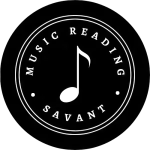| This reading music lesson is a supplement to the Alfred’s Essentials of Music Theory self-study workbook. While no book is perfect for learning how to read music, this is one of the best available. The concise explanations, brief practice exercises, ear-training CD’s, glossary of music terms, and answer key make it an excellent value. Buy this top-rated self-study course for beginners to advanced musicians and follow along with me. |
In the last lesson, we introduced the time signature and what each number means.
This time, we’re going to look specifically at the 4/4 time signature and put it into action.
4/4 Time
If you scroll down and look at the example below, you can see there are four beats in each measure.
This meets the guidelines we talked about earlier when the top number of the time signature is “4”.
The bottom number (also 4) represents a quarter note. This tells us that every quarter note (or quarter rest) will receive one beat.
With this basic information understood, we can now start assigning some counting to each measure.

Measure 1
Since a quarter note equals one beat, we can assign it count “1”. The quarter rest also equals one beat, so we can assign it count “2”. The next quarter note can be “3” while the last quarter rest is “4”.
When we give each note or rest a count using the numbers 1-4, we can see exactly what will happen (either sound or silence) on each of those four beats.
Measure 2
A half note is equal to 2 quarter notes, so it will receive two counts total. Let’s assign it counts “1 & 2” so that we know we are truly holding it for two beats.
We can do the same thing for the half rest by giving it the last two counts (3 & 4).
Measure 3
A whole note is equal to 4 quarter notes, so we need to hold it for four beats total. In order to know we are really doing this while singing or playing, we will assign it counts “1, 2, 3 & 4”.
Notice that 1 whole note takes up the entire measure since we can only have four beats total in that area.
Measure 4
A whole rest equals 4 quarter rests, so we will need four beats of silence here. Just like the whole note in the 3rd measure, we will need to give it counts “1, 2, 3 & 4”.
Again, you can see how the whole rest takes up the entire measure. No other note or rest is needed since we can only have four beats here.
Putting It All Together
This is what it looks like when we begin to put everything you have learned so far together. If you are feeling overwhelmed, go back and review some of the previous lessons.
When you’re ready to move on, join me in the next lesson for a discussion about the 3/4 time signature.
